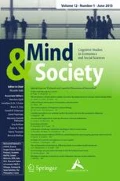Abstract
This paper argues that historical research is an important tool for modeling problem-solving in scientific invention and discovery. Two important cases in the history of modern physics—the invention of the transistor by John Bardeen and Walter Brattain and the development of the theory of superconductivity by Bardeen, Leon Cooper, and J. Robert Schrieffer—reveal factors essential to include in such a model. The focus is on problem-solving practices: problem decomposition, analogy, bridging principles, team-work, empirical tinkering, and library research. A complete framework must encompass the full range of factors, including contingent individual traits and environmental circumstances.
Similar content being viewed by others
References
Amabile, T.M. (1996)Creativity in context (New York, Westview Press).
Bardeen, A. (c. 1913) letter to C.W. Bardeen.
Bardeen, J. (1950) handwritten notes, May 15, Bardeen papers, University of Illinois.
Bardeen, J. (1947) entry in Bell Laboratories Notebook, 20780, December 24, AT&T Archives, Warren NJ.
Bardeen, J. (1951) handwritten notes, October 23, Bardeen papers, University of Illinois.
Bardeen, J. (1977) interviews by L. Hoddeson, May 12 and May 16, American Institute of Physics Center for History of Physics.
Bardeen, J. (1984) interview by W. Aspray, May 29,ieee archives, New Brunswick NJ.
Brattain, W. (1947) entry in Bell Laboratories Notebook, 18194, December 4, AT&T Archives, Warren NJ.
Cartwright, N. (1999) Models and the limits of theory: Quantum Hamiltonians and theBCS model of superconductivity, chapter 9 in M.S. Morgan & M. Morrison (Eds),Models as mediators: Perspectives on natural and social science (Cambridge, Cambridge University Press), pp. 241–81.
Csikszentmihalyi, M. (1996)Creativity: Flow and the psychology of discovery and invention (New York, HarperCollins).
Dunbar, K. (1995) How scientists really reason: Scientific reasoning in real-world laboratories, in R.J. Sternberg & J. Davidson (Eds),The nature of insight (Cambridge MA,Mit Press), pp. 365–96
Feist, G.J. & Gorman, M.E. (1998) The psychology of science: Review and integration of a nascent discipline,Review of General Psychology, 2, 1, pp. 3–47.
Gardner, H. (1993)Creating minds: An anatomy of creativity seen through the lives of Freud, Einstein, Picasso, Stravinsky, Eliot, Graham, and Gandhi (New York, Basic Books).
Giere, R.N. (Ed.) (1992),Cognitive models of science (Minneapolis MN, University of Minnesota Press).
Geison, G.L. (1995)The private science of Louis Pasteur (Princeton NJ, Princeton University Press).
Gruber, H. (1981)Darwin on man: A psychological study of scientific creativity (Chicago, The University of Chicago Press).
Harmor, A. (1936) report in K.C. Mayhew & A.C. Edwards (Eds),The Dewey School: The Laboratory School of the University of Chicago, 1896–1903 (New York, D. Appleton-Century Company), p. 335.
Hoddeson, L. (1981) The discovery of the point-contact transistor,Historical Studies in the Physical Sciences, 12, 1, pp. 41–76.
Hoddeson, L., Braun, E., Teichmann, J. & Weart, S. (Eds) (1992),Out of the crystal maze: A history of solid state physics, 1900–1960 (New York, Oxford University Press).
Hoddeson, L. & Daitch, V. (2002)True genius: The life and science of John Bardeen (Washington D.C., Joseph Henry Press).
Holmes, F.L. (1985)Lavoisier and the chemistry of life: An exploration of scientific creativity (Madison, University of Wisconsin Press).
Kuhn, T. (1970)The structure of scientific revolutions, 2nd edition (Chicago, The University of Chicago Press).
Langley, P., Simon, H., Bradshaw, G. & Zytkow, J. (1987)Scientific discovery: Computational explorations of the creative processes (Cambridge MA,Mit Press).
Nersessian, N.J. (1984)Faraday to Einstein: Constructing meaning in scienctific theories (Dordrecht, Martinus Nijhoff).
Pines, D. (1993) interview by L. Hoddeson and V. Daitch, December 3, University of Illinois at Urbana-Champaign, Illinois.
Riordan, M. & Hoddeson, L. (1997)Crystal fire: The birth of the information age (New York, W.W. Norton and Co.).
Schrieffer, J.R. (1974) interview by J. Warnow and R.M. Williams, September 26, American Institute of Physics Center for History of Physics.
Simonton, D. (1990)Psychology, science, and history: A treatise on their convergence (New Haven CT, Yale University Press).
Sternberg, R.J. (Ed.) (1988),The nature of creativity: Contemporary psychological perspectives (Cambridge, Cambridge University Press).
Sternberg, R.J. (Ed.) (1999),Handbook of creativity (Cambridge, Cambridge University Press).
Sulloway, F.J. (1983)Freud: Biologist of the mind (New York, Basic Books).
Tweney, R.D. (1985) Faraday's discovery of induction: A cognitive approach, in D. Gooding & F. James (Eds),Faraday rediscovered: Essays on the life and work of Michael Faraday: 1791–1867 (New York Stockton Press).
Weisberg, R.W. (1993)Creativity: Beyond the myth of genius (New York, W.H. Freeman).
Zuckerman, H. (1977)Scientific elite: Nobel laureates in the United States (New York, Free Press).
Author information
Authors and Affiliations
Rights and permissions
About this article
Cite this article
Hoddeson, L. Toward a history-based model for scientific invention: Problem-solving practices in the invention of the transistor and the development of the theory of superconductivity. Mind & Society 3, 67–79 (2002). https://doi.org/10.1007/BF02511867
Received:
Accepted:
Issue Date:
DOI: https://doi.org/10.1007/BF02511867



